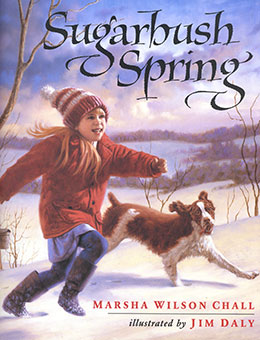Sugarbush Spring
In the month of the Maple Sugar Moon, the snow’s too wet for angel making, icicles rain from Grandpa’s porch roof, and something is stirring in the woods. It’s sugarbush spring—time to tap the trees, prepare the bottles, then gather round the cook fire to eat chicken and dumplings, roast marshmallows, and tell stories while the cold sap heats through, thickens, and boils to make syrup.
Awards and Recognition
Ohio Farm Bureau Federation Award for Children’s Literature, 2002
Resources
- Measure the ingredients for one of these maple syrup recipes! Click here or here.
- Look at real photographs of the process of making maple syrup in the Newbery Award-winning book Sugaring Time by Kathryn Lasky.
- Make “Jack-wax” by pouring maple syrup over crushed ice. Trace a maple leaf and write words that describe the taste and feel of jack-wax when you eat it.
- Invite someone who taps trees to come and talk.
Thanks to Kathy Johnson, media specialist in Alexandria, Minnesota, for these suggestions.
Reviews
This evocative tale illuminates life on a northern farm in early spring, when “the snow’s too wet for angel making” and the sap’s on the rise. The girl narrator rides with her grandfather on a horse-drawn sleigh filled with pails to hang on the taps they will soon place in the sugar maples. As the two search for prospects, Grandpa explains how to pick them: one tree is too old to tap (“She’s given and given till she’s nearly given out”) and another is too young (“She needs all the sugar she makes this year. She’ll be ready when she fills up your arms”). Chall (Up North at the Cabin) maintains this folksy yet informative tone throughout her account, marrying concrete information, such as the 219-degree boiling point of the sap, with more atmospheric descriptions of the sugarhouse itself. Rendered in oil on board, Daly’s (Mother, I Love You) nearly photographic paintings endow the picturesque interior and outdoor settings with a feeling of timelessness. The artist’s devotion to detail—the gleam of light on freshly washed glass jars that will be filled with syrup and the distinct grain of the wood on the sugarhouse walls—contributes to the tactile quality of the volume. (Publishers Weekly)
It is the month of the Maple Sugar Moon in Minnesota-time to collect the sap from the old family sugar bush, and Grandpa invites his youngest granddaughter to help him with this annual event. It is she who tells this warm, engaging story of how hundreds of gallons of sap are turned into the precious maple syrup. Grandpa continues to use the old bucket-drop method of gathering sap, not the modern vacuum-tube system. The girl also tells about the important traditions that surround this event: everyone pitching in to help, enjoying Grandma’s chicken and dumplings in the sugarhouse, and playing games until the syrup is ready. The descriptive language draws readers into the scene effectively. One can almost feel the “maple steam” that fills the sugarhouse and experience the “cotton-candy sweet” smell in the air. The somewhat idealized, detailed, bright, double-page oil paintings are equally effective. This book is great as a read-aloud for introducing children anywhere to maple sugaring, or for young readers to enjoy on their own. (School Library Journal)

illustrator, Jim Daly
HarperCollins, 2000
ISBN 978–0‑68814–9079
ages 4 and up
32 pages
